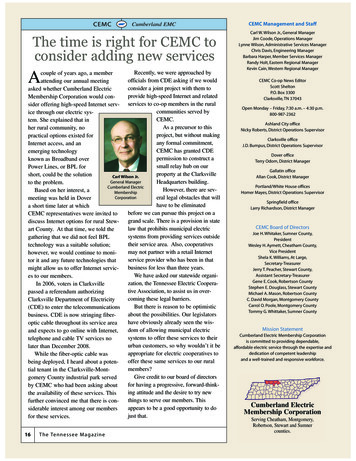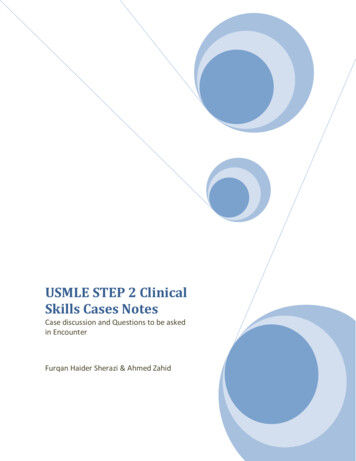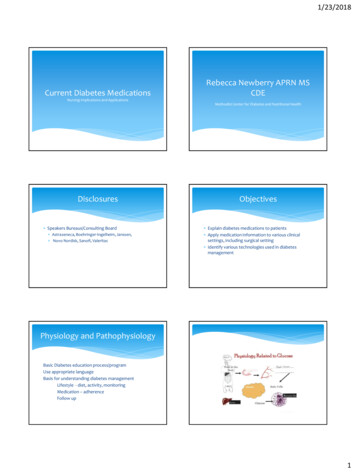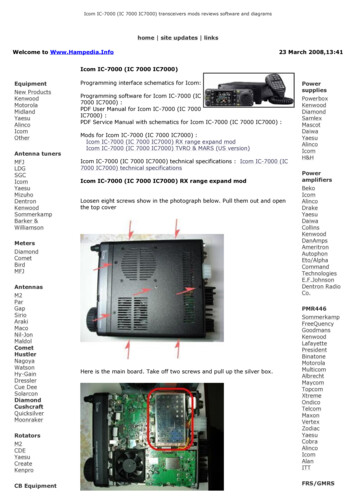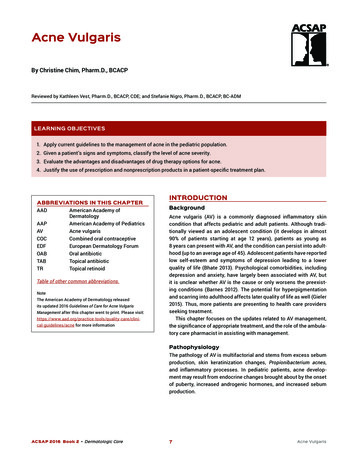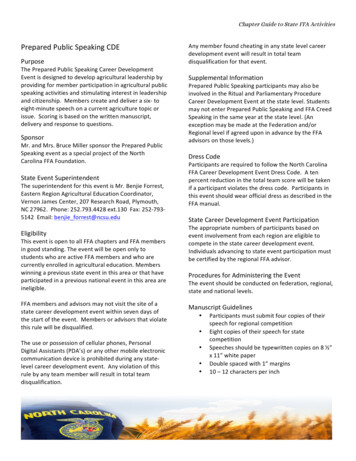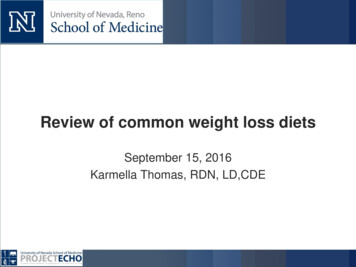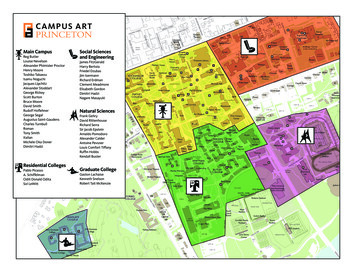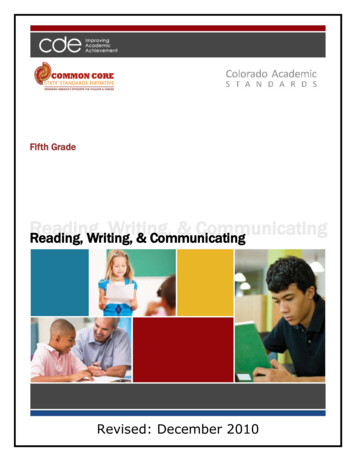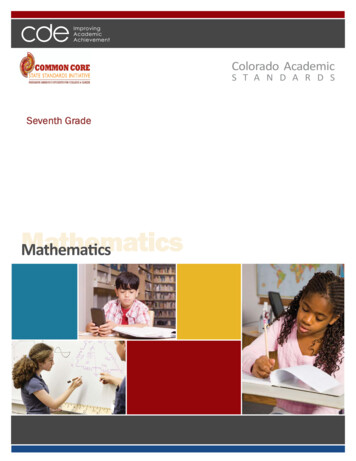
Transcription
Colorado AcademicS T A N D A R D SMathematicsMathematics
Colorado Academic Standards inMathematicsandThe Common Core State Standards forMathematicsOn December 10, 2009, the Colorado State Board of Education adopted the revisedMathematics Academic Standards, along with academic standards in nine othercontent areas, creating Colorado’s first fully aligned preschool through high schoolacademic expectations. Developed by a broad spectrum of Coloradans representingPre-K and K-12 education, higher education, and business, utilizing the best nationaland international exemplars, the intention of these standards is to prepare Coloradoschoolchildren for achievement at each grade level, and ultimately, for successfulperformance in postsecondary institutions and/or the workforce.Concurrent to the revision of the Colorado standards was the Common Core StateStandards (CCSS) initiative, whose process and purpose significantly overlapped withthat of the Colorado Academic Standards. Led by the Council of Chief State SchoolOfficers (CCSSO) and the National Governors Association (NGA), these standardspresent a national perspective on academic expectations for students, Kindergartenthrough High School in the United States.Upon the release of the Common Core State Standards for Mathematics on June 2,2010, the Colorado Department of Education began a gap analysis process todetermine the degree to which the expectations of the Colorado Academic Standardsaligned with the Common Core. The independent analysis proved a nearly 95%alignment between the two sets of standards. On August 2, 2010, the Colorado StateBoard of Education adopted the Common Core State Standards, and requested theintegration of the Common Core State Standards and the Colorado AcademicStandards.In partnership with the dedicated members of the Colorado Standards RevisionSubcommittee in Mathematics, this document represents the integration of thecombined academic content of both sets of standards, maintaining the unique aspectsof the Colorado Academic Standards, which include personal financial literacy, 21stcentury skills, school readiness competencies, postsecondary and workforce readinesscompetencies, and preschool expectations. The result is a world-class set ofstandards that are greater than the sum of their parts.The Colorado Department of Education encourages you to review the Common CoreState Standards and the extensive appendices at www.corestandards.org. While allthe expectations of the Common Core State Standards are embedded and codedwith CCSS: in this document, additional information on the development and theintentions behind the Common Core State Standards can be found on the website.CDE: 7th Grade MathematicsRevised: December 2010Page 2 of 30
Colorado Academic StandardsMathematics Standards“Pure mathematics is, in its way, the poetry of logical ideas.”Albert Einstein “If America is to maintain our high standard of living, we must continue to innovate. We are competingwith nations many times our size. We don't have a single brain to waste. Math and science are theengines of innovation. With these engines we can lead the world. We must demystify math and scienceso that all students feel the joy that follows understanding.”Dr. Michael Brown, Nobel Prize Laureate stIn the 21 century, a vibrant democracy depends on the full, informed participation of all people. Wehave a vast and rapidly growing trove of information available at any moment. However, beinginformed means, in part, using one’s sense of number, shape, data and symbols to organize, interpret,make and assess the validity of claims about quantitative information. In short, informed members ofsociety know and do mathematics.Mathematics is indispensable for understanding our world. In addition to providing the tools ofarithmetic, algebra, geometry and statistics, it offers a way of thinking about patterns andrelationships of quantity and space and the connections among them. Mathematical reasoning allowsus to devise and evaluate methods for solving problems, make and test conjectures about propertiesand relationships, and model the world around us.CDE: 7th Grade MathematicsRevised: December 2010Page 3 of 30
Standards Organization and ConstructionAs the subcommittee began the revision process to improve the existing standards, it became evidentthat the way the standards information was organized, defined, and constructed needed to changefrom the existing documents. The new design is intended to provide more clarity and direction forteachers, and to show how 21st century skills and the elements of school readiness and postsecondaryand workforce readiness indicators give depth and context to essential learning.The “Continuum of State Standards Definitions” section that follows shows the hierarchical order of thestandards components. The “Standards Template” section demonstrates how this continuum is put intopractice.The elements of the revised standards are:Prepared Graduate Competencies: The preschool through twelfth-grade concepts and skills that allstudents who complete the Colorado education system must master to ensure their success in apostsecondary and workforce setting.Standard: The topical organization of an academic content area.High School Expectations: The articulation of the concepts and skills of a standard that indicates astudent is making progress toward being a prepared graduate. What do students need to know in highschool?Grade Level Expectations: The articulation (at each grade level), concepts, and skills of a standardthat indicate a student is making progress toward being ready for high school. What do students needto know from preschool through eighth grade?Evidence Outcomes: The indication that a student is meeting an expectation at the mastery level.How do we know that a student can do it?21st Century Skills and Readiness Competencies: Includes the following:Inquiry Questions:Sample questions are intended to promote deeper thinking,understandings precisely related to the grade level expectation.reflectionandrefinedRelevance and Application:Examples of how the grade level expectation is applied at home, on the job or in a real-world,relevant context.Nature of the Discipline:The characteristics and viewpoint one keeps as a result of mastering the grade levelexpectation.CDE: 7th Grade MathematicsRevised: December 2010Page 4 of 30
Continuum of State Standards DefinitionsPrepared Graduate CompetencyPrepared Graduate Competencies are the P12 concepts and skills that all studentsleaving the Colorado education system musthave to ensure success in a postsecondaryand workforce setting.StandardsStandards are the topical organization of anacademic content area.P-8High SchoolGrade Level ExpectationsExpectations articulate, at each gradelevel, the knowledge and skills of astandard that indicates a student ismaking progress toward high school.What do students need to know?EvidenceOutcomesEvidence outcomesare the indicationthat a student ismeeting anexpectation at themastery level.How do we know thata student can do it?21st Century andPWR SkillsInquiry Questions:Sample questions intendedto promote deeper thinking,reflection and refinedunderstandings preciselyrelated to the grade levelexpectation.Relevance andApplication:Examples of how the gradelevel expectation is appliedat home, on the job or in areal-world, relevant context.High School ExpectationsExpectations articulate the knowledgeand skills of a standard that indicates astudent is making progress towardbeing a prepared graduate.What do students need to know?EvidenceOutcomesEvidence outcomesare the indicationthat a student ismeeting anexpectation at themastery level.How do we know thata student can do it?Nature of theDiscipline:The characteristics andviewpoint one keeps as aresult of mastering the gradelevel expectation.CDE: 7th Grade MathematicsRevised: December 201021st Century andPWR SkillsInquiry Questions:Sample questions intendedto promote deeper thinking,reflection and refinedunderstandings preciselyrelated to the grade levelexpectation.Relevance andApplication:Examples of how the gradelevel expectation is appliedat home, on the job or in areal-world, relevant context.Nature of theDiscipline:The characteristics andviewpoint one keeps as aresult of mastering thegrade level expectation.Page 5 of 30
STANDARDS TEMPLATEContent Area: NAME OF CONTENT AREAStandard: The topical organization of an academic content area.Prepared Graduates: The P-12 concepts and skills that all students who complete the Colorado education system must masterto ensure their success in a postsecondary and workforce settingHigh School and Grade Level ExpectationsConcepts and skills students master:Grade Level Expectation: High Schools: The articulation of the concepts and skills of a standard that indicates astudent is making progress toward being a prepared graduate.Grade Level Expectations: The articulation, at each grade level, the concepts and skills of a standard thatindicates a student is making progress toward being ready for high school.What do students need to know?Evidence Outcomes21st Century Skills and Readiness CompetenciesStudents can:Inquiry Questions:Evidence outcomes are the indicationthat a student is meeting anexpectation at the mastery level.Sample questions intended to promote deeper thinking, reflection andrefined understandings precisely related to the grade level expectation.How do we know that a student cando it?Relevance and Application:Examples of how the grade level expectation is applied at home, on thejob or in a real-world, relevant context.Nature of the Discipline:The characteristics and viewpoint one keeps as a result of mastering thegrade level expectation.Colorado Department of Education: 7th Grade MathematicsRevised: December 2010Page 6 of 30
Prepared Graduate Competencies in MathematicsThe prepared graduate competencies are the preschool through twelfth-grade concepts and skills thatall students who complete the Colorado education system must master to ensure their success in apostsecondary and workforce setting.Prepared graduates in mathematics: Understand the structure and properties of our number system. At their most basic levelnumbers are abstract symbols that represent real-world quantities Understand quantity through estimation, precision, order of magnitude, and comparison. Thereasonableness of answers relies on the ability to judge appropriateness, compare, estimate,and analyze error Are fluent with basic numerical and symbolic facts and algorithms, and are able to select anduse appropriate (mental math, paper and pencil, and technology) methods based on anunderstanding of their efficiency, precision, and transparency Make both relative (multiplicative) and absolute (arithmetic) comparisons between quantities.Multiplicative thinking underlies proportional reasoning Recognize and make sense of the many ways that variability, chance, and randomness appearin a variety of contexts Solve problems and make decisions that depend on understanding, explaining, and quantifyingthe variability in data Understand that equivalence is a foundation of mathematics represented in numbers, shapes,measures, expressions, and equations Make sound predictions and generalizations based on patterns and relationships that arise fromnumbers, shapes, symbols, and data Apply transformation to numbers, shapes, functional representations, and data Make claims about relationships among numbers, shapes, symbols, and data and defend thoseclaims by relying on the properties that are the structure of mathematics Communicate effective logical arguments using mathematical justification and proof.Mathematical argumentation involves making and testing conjectures, drawing validconclusions, and justifying thinking Use critical thinking to recognize problematic aspects of situations, create mathematicalmodels, and present and defend solutionsCDE: 7th Grade MathematicsRevised: December 2010Page 7 of 30
Colorado Academic StandardsMathematicsThe Colorado academic standards in mathematics are the topical organization of the concepts andskills every Colorado student should know and be able to do throughout their preschool throughtwelfth-grade experience.1. Number Sense, Properties, and OperationsNumber sense provides students with a firm foundation in mathematics. Students build a deepunderstanding of quantity, ways of representing numbers, relationships among numbers, andnumber systems. Students learn that numbers are governed by properties and understandingthese properties leads to fluency with operations.2. Patterns, Functions, and Algebraic StructuresPattern sense gives students a lens with which to understand trends and commonalities.Students recognize and represent mathematical relationships and analyze change. Studentslearn that the structures of algebra allow complex ideas to be expressed succinctly.3.DataAnalysis, Statistics, and ProbabilityData and probability sense provides students with tools to understand information anduncertainty. Students ask questions and gather and use data to answer them. Students use avariety of data analysis and statistics strategies to analyze, develop and evaluate inferencesbased on data. Probability provides the foundation for collecting, describing, and interpretingdata.4. Shape, Dimension, and Geometric RelationshipsGeometric sense allows students to comprehend space and shape. Students analyze thecharacteristics and relationships of shapes and structures, engage in logical reasoning, and usetools and techniques to determine measurement. Students learn that geometry andmeasurement are useful in representing and solving problems in the real world as well as inmathematics.Modeling Across the StandardsModeling links classroom mathematics and statistics to everyday life, work, and decision-making.Modeling is the process of choosing and using appropriate mathematics and statistics to analyzeempirical situations, to understand them better, and to improve decisions. When making mathematicalmodels, technology is valuable for varying assumptions, exploring consequences, and comparingpredictions with data. Modeling is best interpreted not as a collection of isolated topics but rather inrelation to other standards, specific modeling standards appear throughout the high school standardsindicated by a star symbol (*).CDE: 7th Grade MathematicsRevised: December 2010Page 8 of 30
Standards for Mathematical PracticefromThe Common Core State Standards for MathematicsThe Standards for Mathematical Practice have been included in the Nature of Mathematics section ineach Grade Level Expectation of the Colorado Academic Standards. The following definitions andexplanation of the Standards for Mathematical Practice from the Common Core State Standards can befound on pages 6, 7, and 8 in the Common Core State Standards for Mathematics. Each MathematicalPractices statement has been notated with (MP) at the end of the statement.Mathematics Standards for Mathematical PracticeThe Standards for Mathematical Practice describe varieties of expertise that mathematics educators atall levels should seek to develop in their students. These practices rest on important “processes andproficiencies” with longstanding importance in mathematics education. The first of these are the NCTMprocess standards of problem solving, reasoning and proof, communication, representation, andconnections. The second are the strands of mathematical proficiency specified in the National ResearchCouncil’s report Adding It Up: adaptive reasoning, strategic competence, conceptual understanding(comprehension of mathematical concepts, operations and relations), procedural fluency (skill incarrying out procedures flexibly, accurately, efficiently and appropriately), and productive disposition(habitual inclination to see mathematics as sensible, useful, and worthwhile, coupled with a belief indiligence and one’s own efficacy).1. Make sense of problems and persevere in solving them.Mathematically proficient students start by explaining to themselves the meaning of a problem andlooking for entry points to its solution. They analyze givens, constraints, relationships, and goals. Theymake conjectures about the form and meaning of the solution and plan a solution pathway rather thansimply jumping into a solution attempt. They consider analogous problems, and try special cases andsimpler forms of the original problem in order to gain insight into its solution. They monitor andevaluate their progress and change course if necessary. Older students might, depending on thecontext of the problem, transform algebraic expressions or change the viewing window on theirgraphing calculator to get the information they need. Mathematically proficient students can explaincorrespondences between equations, verbal descriptions, tables, and graphs or draw diagrams ofimportant features and relationships, graph data, and search for regularity or trends. Younger studentsmight rely on using concrete objects or pictures to help conceptualize and solve a problem.Mathematically proficient students check their answers to problems using a different method, and theycontinually ask themselves, “Does this make sense?” They can understand the approaches of others tosolving complex problems and identify correspondences between different approaches.2. Reason abstractly and quantitatively.Mathematically proficient students make sense of quantities and their relationships in problemsituations. They bring two complementary abilities to bear on problems involving quantitativerelationships: the ability to decontextualize—to abstract a given situation and represent it symbolicallyand manipulate the representing symbols as if they have a life of their own, without necessarilyattending to their referents—and the ability to contextualize, to pause as needed during themanipulation process in order to probe into the referents for the symbols involved. Quantitativereasoning entails habits of creating a coherent representation of the problem at hand; considering theunits involved; attending to the meaning of quantities, not just how to compute them; and knowingand flexibly using different properties of operations and objects.3. Construct viable arguments and critique the reasoning of others.Mathematically proficient students understand and use stated assumptions, definitions, and previouslyestablished results in constructing arguments. They make conjectures and build a logical progressionof statements to explore the truth of their conjectures. They are able to analyze situations by breakingthem into cases, and can recognize and use counterexamples. They justify their conclusions,communicate them to others, and respond to the arguments of others. They reason inductively aboutdata, making plausible arguments that take into account the context from which the data arose.CDE: 7th Grade MathematicsRevised: December 2010Page 9 of 30
Mathematically proficient students are also able to compare the effectiveness of two plausiblearguments, distinguish correct logic or reasoning from that which is flawed, and—if there is a flaw inan argument—explain what it is. Elementary students can construct arguments using concretereferents such as objects, drawings, diagrams, and actions. Such arguments can make sense and becorrect, even though they are not generalized or made formal until later grades. Later, students learnto determine domains to which an argument applies. Students at all grades can listen or read thearguments of others, decide whether they make sense, and ask useful questions to clarify or improvethe arguments.4. Model with mathematics.Mathematically proficient students can apply the mathematics they know to solve problems arising ineveryday life, society, and the workplace. In early grades, this might be as simple as writing anaddition equation to describe a situation. In middle grades, a student might apply proportionalreasoning to plan a school event or analyze a problem in the community. By high school, a studentmight use geometry to solve a design problem or use a function to describe how one quantity ofinterest depends on another. Mathematically proficient students who can apply what they know arecomfortable making assumptions and approximations to simplify a complicated situation, realizing thatthese may need revision later. They are able to identify important quantities in a practical situationand map their relationships using such tools as diagrams, two-way tables, graphs, flowcharts andformulas. They can analyze those relationships mathematically to draw conclusions. They routinelyinterpret their mathematical results in the context of the situation and reflect on whether the resultsmake sense, possibly improving the model if it has not served its purpose.5. Use appropriate tools strategically.Mathematically proficient students consider the available tools when solving a mathematical problem.These tools might include pencil and paper, concrete models, a ruler, a protractor, a calculator, aspreadsheet, a computer algebra system, a statistical package, or dynamic geometry software.Proficient students are sufficiently familiar with tools appropriate for their grade or course to makesound decisions about when each of these tools might be helpful, recognizing both the insight to begained and their limitations. For example, mathematically proficient high school students analyzegraphs of functions and solutions generated using a graphing calculator. They detect possible errors bystrategically using estimation and other mathematical knowledge. When making mathematical models,they know that technology can enable them to visualize the results of varying assumptions,explore consequences, and compare predictions with data. Mathematically proficient students atvarious grade levels are able to identify relevant external mathematical resources, such as digitalcontent located on a website, and use them to pose or solve problems. They are able to usetechnological tools to explore and deepen their understanding of concepts.6. Attend to precision.Mathematically proficient students try to communicate precisely to others. They try to use cleardefinitions in discussion with others and in their own reasoning. They state the meaning of the symbolsthey choose, including using the equal sign consistently and appropriately. They are careful aboutspecifying units of measure, and labeling axes to clarify the correspondence with quantities in aproblem. They calculate accurately and efficiently, express numerical answers with a degree ofprecision appropriate for the problem context. In the elementary grades, students give carefullyformulated explanations to each other. By the time they reach high school they have learned toexamine claims and make explicit use of definitions.7. Look for and make use of structure.Mathematically proficient students look closely to discern a pattern or structure. Young students, forexample, might notice that three and seven more is the same amount as seven and three more, orthey may sort a collection of shapes according to how many sides the shapes have. Later, students willsee 7 8 equals the well remembered 7 5 7 3, in preparation for learning about the distributiveproperty. In the expression x2 9x 14, older students can see the 14 as 2 7 and the 9 as 2 7.They recognize the significance of an existing line in a geometric figure and can use the strategy ofdrawing an auxiliary line for solving problems. They also can step back for an overview and shiftperspective. They can see complicated things, such as some algebraic expressions, as single objects orCDE: 7th Grade MathematicsRevised: December 2010Page 10 of 30
as being composed of several objects. For example, they can see 5 – 3(x – y)2 as 5 minus a positivenumber times a square and use that to realize that its value cannot be more than 5 for any realnumbers x and y.8. Look for and express regularity in repeated reasoning.Mathematically proficient students notice if calculations are repeated, and look both for generalmethods and for shortcuts. Upper elementary students might notice when dividing 25 by 11 that theyare repeating the same calculations over and over again, and conclude they have a repeating decimal.By paying attention to the calculation of slope as they repeatedly check whether points are on the linethrough (1, 2) with slope 3, middle school students might abstract the equation (y – 2)/(x – 1) 3.Noticing the regularity in the way terms cancel when expanding (x – 1)(x 1), (x – 1)(x2 x 1),and (x – 1)(x3 x2 x 1) might lead them to the general formula for the sum of a geometric series.As they work to solve a problem, mathematically proficient students maintain oversight of the process,while attending to the details. They continually evaluate the reasonableness of their intermediateresults.Connecting the Standards for Mathematical Practice to the Standards for MathematicalContentThe Standards for Mathematical Practice describe ways in which developing student practitioners of thediscipline of mathematics increasingly ought to engage with the subject matter as they grow inmathematical maturity and expertise throughout the elementary, middle and high school years.Designers of curricula, assessments, and professional development should all attend to the need toconnect the mathematical practices to mathematical content in mathematics instruction. TheStandards for Mathematical Content are a balanced combination of procedure and understanding.Expectations that begin with the word “understand” are often especially good opportunities to connectthe practices to the content. Students who lack understanding of a topic may rely on procedures tooheavily. Without a flexible base from which to work, they may be less likely to consider analogousproblems, represent problems coherently, justify conclusions, apply the mathematics to practicalsituations, use technology mindfully to work with the mathematics, explain the mathematics accuratelyto other students, step back for an overview, or deviate from a known procedure to find a shortcut. Inshort, a lack of understanding effectively prevents a student from engaging in the mathematicalpractices. In this respect, those content standards which set an expectation of understanding arepotential “points of intersection” between the Standards for Mathematical Content and the Standardsfor Mathematical Practice. These points of intersection are intended to be weighted toward central andgenerative concepts in the school mathematics curriculum that most merit the time, resources,innovative energies, and focus necessary to qualitatively improve the curriculum, instruction,assessment, professional development, and student achievement in mathematics.CDE: 7th Grade MathematicsRevised: December 2010Page 11 of 30
MathematicsGrade Level Expectations at a GlanceStandardGrade Level ExpectationSeventh Grade1. NumberSense,Properties, andOperations2. Patterns,Functions, andAlgebraicStructures3. DataAnalysis,Statistics, andProbability4. Shape,Dimension, andGeometricRelationships1. Proportional reasoning involves comparisons and multiplicativerelationships among ratios2. Formulate, represent, and use algorithms with rational numbersflexibly, accurately, and efficiently1. Properties of arithmetic can be used to generate equivalentexpressions2. Equations and expressions model quantitative relationships andphenomena1. Statistics can be used to gain information about populations byexamining samples2. Mathematical models are used to determine probability1. Modeling geometric figures and relationships leads to informalspatial reasoning and proof2. Linear measure, angle measure, area, and volume arefundamentally different and require different units of measureFrom the Common State Standards for Mathematics, Page 46.Mathematics Grade 7In Grade 7, instructional time should focus on four critical areas: (1) developing understanding of andapplying proportional relationships; (2) developing understanding of operations with rational numbersand working with expressions and linear equations; (3) solving problems involving scale drawings andinformal geometric constructions, and working with two- and three-dimensional shapes to solveproblems involving area, surface area, and volume; and (4) drawing inferences about populationsbased on samples.(1) Students extend their understanding of ratios and develop understanding of proportionality tosolve single- and multi-step problems. Students use their understanding of ratios and proportionalityto solvea wide variety of percent problems, including those involving discounts, interest, taxes, tips, andpercent increase or decrease. Students solve problems about scale drawings by relating correspondinglengths between the objects or by using the fact that relationships of lengths within an object arepreserved in similar objects. Students graph proportional relationships and understand the unit rateinformally as a measure of the steepness of the related line, called the slope. They distinguishproportional relationships from other relationships.(2) Students develop a unified understanding of number, recognizing fractions, decimals (that have afinite or a repeating decimal representation), and percents as different representations of rationalnumbers. Students extend addition, subtraction, multiplication, and division to all rational numbers,maintaining the properties of operations and the relationships between addition and subtraction, andmultiplication and division. By applying these properties, and by viewing negative numbers in terms ofeveryday contexts (e.g., amounts owed or temperatures below zero), students explain and interpretthe rules for adding, subtracting, multiplying, and dividing with negative
CDE: 7th Grade Mathematics Revised: December 2010 Page 3 of 30 Colorado Academic Standards Mathematics Standards "Pure mathematics is, in its way, the poetry of logical ideas." Albert Einstein "If America is to maintain our high standard of living, we must continue to innovate.
